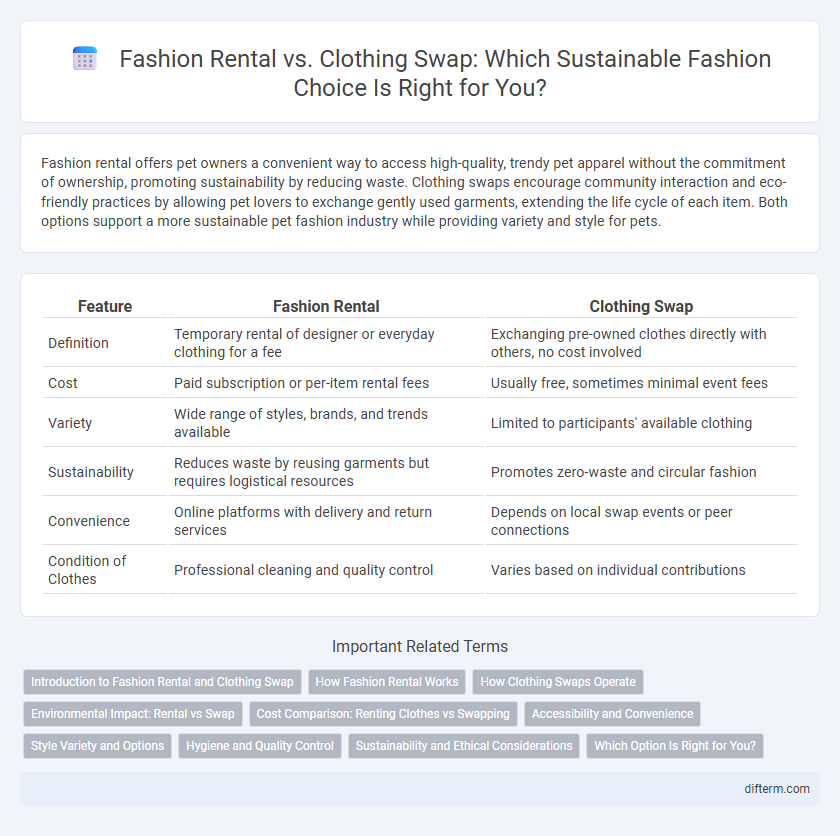Fashion rental offers pet owners a convenient way to access high-quality, trendy pet apparel without the commitment of ownership, promoting sustainability by reducing waste. Clothing swaps encourage community interaction and eco-friendly practices by allowing pet lovers to exchange gently used garments, extending the life cycle of each item. Both options support a more sustainable pet fashion industry while providing variety and style for pets.
Table of Comparison
| Feature | Fashion Rental | Clothing Swap |
|---|---|---|
| Definition | Temporary rental of designer or everyday clothing for a fee | Exchanging pre-owned clothes directly with others, no cost involved |
| Cost | Paid subscription or per-item rental fees | Usually free, sometimes minimal event fees |
| Variety | Wide range of styles, brands, and trends available | Limited to participants' available clothing |
| Sustainability | Reduces waste by reusing garments but requires logistical resources | Promotes zero-waste and circular fashion |
| Convenience | Online platforms with delivery and return services | Depends on local swap events or peer connections |
| Condition of Clothes | Professional cleaning and quality control | Varies based on individual contributions |
Introduction to Fashion Rental and Clothing Swap
Fashion rental services provide access to a variety of high-end and everyday clothing pieces for a limited time, enabling consumers to enjoy new styles without the commitment of purchase. Clothing swap events allow individuals to exchange garments directly, promoting sustainable fashion by extending the life cycle of existing apparel. Both methods support eco-friendly practices by reducing waste and encouraging a circular fashion economy.
How Fashion Rental Works
Fashion rental operates through online platforms or physical stores where customers select garments for temporary use, often ranging from a few days to several weeks. Users pay a rental fee based on the item's value and rental duration, after which they return the clothing, allowing for sustainable wardrobe rotation. This model reduces textile waste by promoting access over ownership and supports high-quality, diverse fashion choices without long-term commitment.
How Clothing Swaps Operate
Clothing swaps operate by facilitating the exchange of pre-owned garments directly between participants, eliminating the need for monetary transactions. These events often occur in community spaces or online platforms where individuals bring items they no longer wear and trade them for pieces that suit their style and size. The process promotes sustainability by extending garment life cycles, reducing textile waste, and encouraging a circular fashion economy.
Environmental Impact: Rental vs Swap
Fashion rental significantly reduces textile waste by extending garment lifecycle through multiple uses, lowering the demand for new production and minimizing carbon emissions compared to fast fashion. Clothing swaps promote circularity by encouraging the direct exchange of pre-loved items, cutting down on resource consumption and diverting textiles from landfills without generating excess packaging or transport emissions. Both models support sustainable consumption, but rentals often involve carbon footprints from shipping logistics, whereas swaps emphasize local, community-driven exchanges with minimal environmental costs.
Cost Comparison: Renting Clothes vs Swapping
Fashion rental typically involves monthly subscription fees or per-item charges ranging from $30 to $150, offering access to high-end garments without long-term investment. Clothing swaps incur minimal costs, usually limited to event fees or membership dues under $20, promoting sustainable fashion through peer-to-peer exchange. Renting suits consumers seeking variety and convenience, while swapping appeals to budget-conscious individuals prioritizing environmental impact and community engagement.
Accessibility and Convenience
Fashion rental services offer unparalleled accessibility by providing a vast selection of high-end and everyday garments shipped directly to consumers, eliminating the need for physical store visits. Clothing swaps rely on peer-to-peer exchanges, which can be limited by local availability and scheduling constraints, reducing convenience. Rental platforms often feature user-friendly apps and flexible return policies, enhancing overall ease and broadening access beyond immediate social circles.
Style Variety and Options
Fashion rental services offer access to a diverse range of designer garments and trendy styles that can frequently be updated, providing unparalleled variety compared to traditional wardrobes. Clothing swaps emphasize sustainability and community engagement, allowing participants to exchange unique, pre-owned pieces that reflect personal styles while fostering a sense of individuality. Rental platforms often feature curated collections and exclusive brands, whereas swaps rely on the eclectic inventory of participants, resulting in differing scopes of style options and frequency of wardrobe refreshes.
Hygiene and Quality Control
Fashion rental services implement strict hygiene protocols, including professional dry cleaning and sanitization between uses, ensuring garments meet high standards of cleanliness and quality. Clothing swaps rely on participants' personal care, which can vary widely, potentially compromising hygiene and garment condition. Quality control is more consistent in rental platforms due to systematic inspections, while swaps depend largely on the honesty and diligence of individual contributors.
Sustainability and Ethical Considerations
Fashion rental platforms reduce textile waste by extending garment lifespans through shared use, significantly lowering the demand for new clothing production and its associated environmental impact. Clothing swaps promote ethical consumption by fostering community engagement and minimizing carbon footprints through direct garment exchange, bypassing industrial processes. Both models support sustainable fashion by emphasizing resource efficiency and reducing landfill contributions from fast fashion.
Which Option Is Right for You?
Fashion rental offers access to a wide variety of designer pieces for special occasions or trends without long-term commitment, making it ideal for those seeking versatility and novelty. Clothing swaps provide a budget-friendly, sustainable way to refresh wardrobes by exchanging pre-loved items within communities, perfect for environmentally conscious individuals valuing personal connections. Choosing between rental and swap depends on your style preferences, frequency of use, and sustainability priorities.
Fashion Rental vs Clothing Swap Infographic

 difterm.com
difterm.com